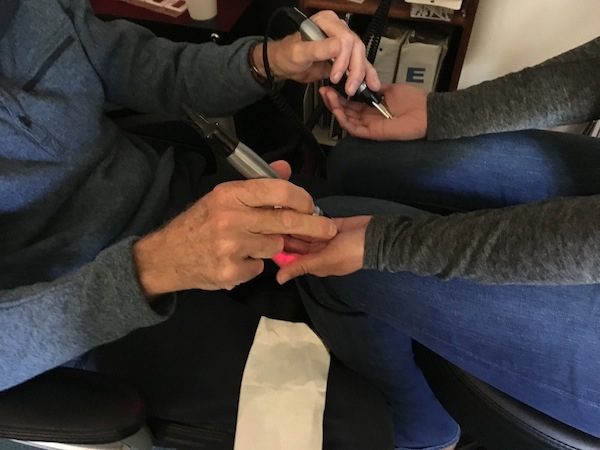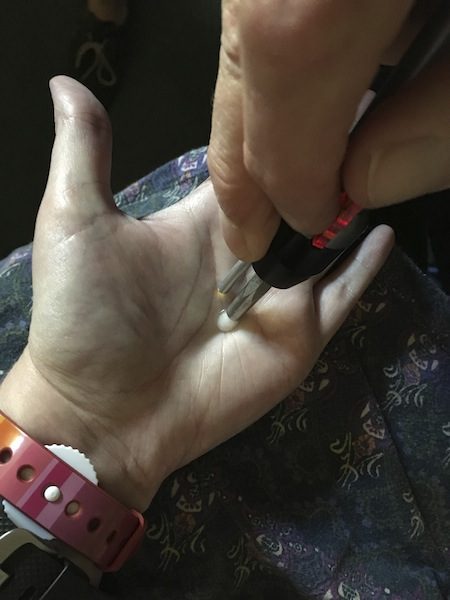Dr. Gregory Nevens is a health psychologist at the Integrative Health Center of Maine. His specialties are chronic illnesses, chronic pain, and PTSD.
For the past 15 years, Dr. Nevens has been using and perfecting a technique called Traumatic Emotional Reintegration System (TERS). It’s designed to help people recover from PTSD. “Not to take away the bad memories of the traumatic event,” Dr. Nevens explained, “but to neutralize the flashbacks and nightmares associated with full re-experiencing of the event with all of the senses and emotional turmoil. One can choose to think about a bad memory or not, but once in a flashback there is no such choice until the re-experiencing is over.”
One of his patients, who wanted to remain anonymous, gave me permission to sit in on her treatment session. She had PTSD because she had witnessed the unexpected death of a close family member.
She and Dr. Nevens sat across from each other in his office. He told her to close her eyes and imagine that she was sinking into a comfortable chair in a room that felt safe.
He helped her relax by stimulating specific acupuncture/acupressure points. Instead of needles, he used a soft probe that delivers an extremely mild microcurrent. “This is not adding electricity to the system,” Dr. Nevens explained. “It’s what the autonomic nervous system uses to govern all the organs in the body. It’s very, very mild. People don’t even feel it. But it’s very helpful. It allows
One of the points is known as pericardium 8. “It’s the protector of the heart,” said Dr. Nevens. “Usually, the first emotions that people identify when they have PTSD are anxiety and fear. They feel that in their chest, so the heart meridian is key in work with PTSD.”
The goal is to break up the energy patterns in PTSD flashbacks evidenced in the neuroscience. “In intrusive episodes,” he said, “some areas of the brain become hyperactive, others hypoactive. With PTSD, something triggers the traumatic re-experiencing. It could be an olfactory trigger. It could be a visual trigger. It could be an auditory trigger. In nightmares, it’s the unconscious going back to try to get a different perspective with an extraordinary overwhelming experience.”
He told his patient, who was, at that point, very relaxed, to imagine there was a projector in the room. When she was ready, he quietly asked her to turn it on and “play the movie” of her traumatic event. She was to start it before anything bad had happened and to play it all the way to the end.
It took her several minutes and about half way through, tears were streaming down her face. The entire time, Dr. Nevens continued to stimulate pericardium 8.
Changing the pace and direction, he had the patient review her trauma several more times. Doing that in conjunction with the electroacupuncture helped break up the energy flow. When she was done, he asked her how she was feeling. “Sad,” she replied. “Very sad.”
Other common emotions are anger and guilt. Dr. Nevens usually stimulates specific points according to a person’s reaction. The large intestine, for instance, if someone feels guilty.
“I’m basically matching some of these powerful acupressure points using this technology to work through one emotion after another,” he said. “I’ve had patients where I only had to use Pericardium 8 and they recognize that it’s changed to a bad memory instead of a flashback. But I’ve also had to work through all these different emotional layers with some people, kind of like peeling an onion.”

When Dr. Nevens is doing the electroacupuncture he also applies color to the meridian points. For the most part, he uses magenta because it combines both ends of the color spectrum. He says often times when people are reliving a trauma, they see it in black and white. “Toward the end of the treatment I ask them if they see it in color now and if they say yes, it’s done. They’re good to go.”
Another patient, who also asked to remain anonymous, sent me a written explanation of how TERS worked for him. He was living in Manhattan on 9/11 and dealt with severe PTSD.
“For many years following,” he wrote, “I experienced nightmares, flashbacks, vivid sense memories, that were frightening and distressing. They could be brought on by the smell of a building site, the sight and sound of a plane flying overhead, terrorist-related events in the news, even the smell in the air on a nice sunny fall day would often bring me back to that time.”
Fourteen years after the event, he found himself in Dr. Nevens’ office.
“Dr. Nevens’ techniques, in a very short amount of time (one 20 minute session)removed the powerful hold that that day had on me. The memories themselves have not disappeared, but the sense of anxiety, panic, and dread, that accompanied them has been alleviated. The Traumatic Emotional Reintegration System, to my amazement, has taken the sting out of that experience- something I was, I must admit, a bit skeptical could ever happen. I can talk about the events now, albeit with great sadness and a profound sense of tragedy. Before, I could hardly speak of them at all. Allowing me to talk and work through those experiences helped in the therapeutic process as well. I no longer have the powerful nightmares and flashbacks. I do have memories, of course, and they are provoked by many of the same things, but they are just that, memories. The painful, indeed, nauseating, feelings associated with them are gone.”
And that is the goal whenever Dr. Nevens uses TERS to help someone with PTSD. “To turn the full re-experiencing of flashbacks characteristic of PTSD into bad memories that one can choose to think of are not”
As for the young woman who let me observe her treatment, Dr. Nevens says that she “has not experienced any more intrusive episodes (nightmares and flashbacks, the primary PTSD symptoms) since the brief treatment.”
Dr. Nevens has taught this technique around the country, including in his office at the Integrative Health Center of Maine. He said, “I continue to be very interested in training more practitioners locally and expanding my research.”



Leave A Comment